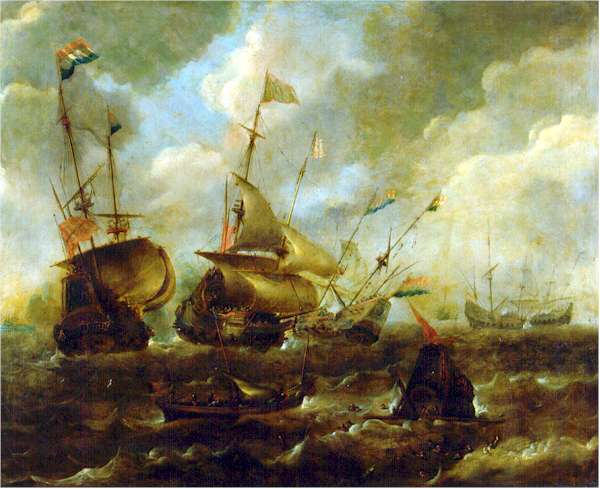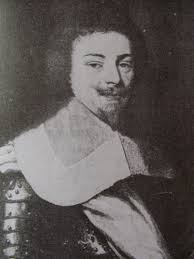|
Claude De Razilly
Claude de Razilly, also Claude de Launay-Razilly (1593-1654). was a French Navy officer. He was the brother of François de Razilly and Isaac de Razilly. Claude de Razilly fought in the Siege of Saint-Martin-de-Ré (1627) in 1627 and the Siege of La Rochelle. In 1627, he successfully relieved the siege of the Royal forces in the fortress of Saint-Martin-de-Ré by sailing through an important English naval blockade. In 1632, he was given by Richelieu in association with his brother Isaac de Razilly a mission to recover Acadia from the English following the Treaty of Saint-Germain. He was Governor of Acadia when Port Royal was recovered in 1634. Three years later, Claude de Razilly was succeeded as Acadian Governor by two contenders, Charles de Menou d'Aulnay and Charles de Saint-Étienne de la Tour Charles de Saint-Étienne de La Tour (1593–1666) was a French colonist and fur trader who served as Governor of Acadia from 1631–1642 and again from 1653–1657. Early life ... [...More Info...] [...Related Items...] OR: [Wikipedia] [Google] [Baidu] |
List Of Acadian Governors
The governance of the French colony of Acadia has a long and tangled history. Founded in 1603 by Pierre Dugua, Sieur de Monts, the territory of Acadia (roughly, the present-day Canadian provinces of Nova Scotia, New Brunswick, and Prince Edward Island, and portions of the U. S. state of Maine) was hotly contested in the 17th century. It was claimed by English and Scottish interests, fought over by competing French governors, and subjected to raids and attacks from English colonists that sometimes resulted in years of occupation of some of its communities. Most of the non-French claims were given up under the 1667 Treaty of Breda, but the territory did not come completely under French control until three years later. From 1670 until 1710 the province remained in French hands, except for a brief period in the 1670s when Dutch attackers occupied several Acadian communities. In 1710 a British expedition including Royal Navy warships and colonial forces from New England captured ... [...More Info...] [...Related Items...] OR: [Wikipedia] [Google] [Baidu] |
Year Of Birth Unknown
A year or annus is the orbital period of a planetary body, for example, the Earth, moving in its orbit around the Sun. Due to the Earth's axial tilt, the course of a year sees the passing of the seasons, marked by change in weather, the hours of daylight, and, consequently, vegetation and soil fertility. In temperate and subpolar regions around the planet, four seasons are generally recognized: spring, summer, autumn and winter. In tropical and subtropical regions, several geographical sectors do not present defined seasons; but in the seasonal tropics, the annual wet and dry seasons are recognized and tracked. A calendar year is an approximation of the number of days of the Earth's orbital period, as counted in a given calendar. The Gregorian calendar, or modern calendar, presents its calendar year to be either a common year of 365 days or a leap year of 366 days, as do the Julian calendars. For the Gregorian calendar, the average length of the calendar year ( ... [...More Info...] [...Related Items...] OR: [Wikipedia] [Google] [Baidu] |
1637 Deaths
Events January–March * January 5 – Pierre Corneille's tragicomedy ''Le Cid'' is first performed, in Paris, France. * January 16 – The siege of Nagpur ends in what is now the Maharashtra state of India, as Kok Shah, the King of Deogarh, surrenders his kingdom to the Mughal Empire. * January 23 – John Maurice, Prince of Nassau-Siegen arrives from the Netherlands to become the Governor of Dutch Brazil, and extends the range of the colony over the next six years. * January 28 – The Manchu armies of China complete their invasion of northern Korea with the surrender of King Injo of the Joseon Kingdom. * February 3 – Tulip mania collapses in the Dutch Republic. * February 15 – Ferdinand III becomes Holy Roman Emperor upon the death of his father, Ferdinand II, although his formal coronation does not take place until later in the year. * February 18 – Eighty Years' War – Battle off Lizard Point: Off the coast of Co ... [...More Info...] [...Related Items...] OR: [Wikipedia] [Google] [Baidu] |
French Navy Officers
French (french: français(e), link=no) may refer to: * Something of, from, or related to France ** French language, which originated in France, and its various dialects and accents ** French people, a nation and ethnic group identified with France ** French cuisine, cooking traditions and practices Fortnite French places Arts and media * The French (band), a British rock band * "French" (episode), a live-action episode of ''The Super Mario Bros. Super Show!'' * ''Française'' (film), 2008 * French Stewart (born 1964), American actor Other uses * French (surname), a surname (including a list of people with the name) * French (tunic), a particular type of military jacket or tunic used in the Russian Empire and Soviet Union * French's, an American brand of mustard condiment * French catheter scale, a unit of measurement of diameter * French Defence, a chess opening * French kiss, a type of kiss involving the tongue See also * France (other) * Franch, a surname * French ... [...More Info...] [...Related Items...] OR: [Wikipedia] [Google] [Baidu] |
Battle Of Guetaria
The Battle of Getaria was fought on 22 August 1638 during the Franco-Spanish War (1635–59), at Getaria, in northern Spain. A French naval force commanded by Henri de Sourdis attacked and destroyed a Spanish squadron under Lope de Hoces, who survived but was killed at the Battle of the Downs in 1639. The French fleet was being used to support the siege of Fuenterrabía, a vital Spanish port. By early August, the blockade meant the town was close to starvation. To provide time for a relief force to reach the defenders, de Hoces was ordered to draw their ships away; despite the almost total destruction of his force, the siege was lifted in September 1638. Although ultimately Getaria had little strategic impact, it was the first significant victory for the newly formed French Navy; Cardinal Richelieu viewed it as vindication of the decision taken in 1624 to invest large sums in its expansion. Background Prior to the outbreak of the Franco-Spanish War in 1635, Spain was alread ... [...More Info...] [...Related Items...] OR: [Wikipedia] [Google] [Baidu] |
Charles De Saint-Étienne De La Tour
Charles de Saint-Étienne de La Tour (1593–1666) was a French colonist and fur trader who served as Governor of Acadia from 1631–1642 and again from 1653–1657. Early life Charles de Saint-Étienne de La Tour was born in France in 1593 to Huguenot Claude de Saint-Étienne de la Tour and his wife Marie Amador de Salazar, a descendant of Georges de La Trémoille, the Grand Chamberlain of France to King Charles VII of France. In 1610, at the age of 17, Charles arrived at Port-Royal in Acadia with his father in an expedition led by Jean de Biencourt de Poutrincourt who had been one of the original settlers in 1604 at Saint Croix Island, Maine before they moved in 1605 to their permanent settlement at Port-Royal. The habitation had been previously abandoned in 1607 by Biencourt de Poutrincourt and others due to financial troubles. The 1610 expedition also included Poutrincourt's 19-year-old son Charles de Biencourt de Saint-Just and a Catholic priest who set about the task of b ... [...More Info...] [...Related Items...] OR: [Wikipedia] [Google] [Baidu] |
Charles De Menou D'Aulnay
Charles de Menou d'Aulnay (''de Charnisay'') (–1650) was a French pioneer of European settlement in North America and Governor of Acadia (1635–1650). Biography D'Aulnay was a member of the French nobility who was at various times a sea captain, a lieutenant in the French navy to his cousin Isaac de Razilly, and Governor of Acadia (now primarily Nova Scotia and New Brunswick, Canada). He was born at Château de Charnizay, Indre-et-Loire, France. His father was a high-ranking official for Louis XIII. Isaac de Razilly, having been selected by the government to restore to France her Acadian possessions, became governor of Acadia in 1632, and d'Aulnay was one of his able assistants, borrowing funds, hiring ships, and recruiting men for the regular ocean crossings to and from France for the Compagnie des Cent-Associés and a private company, Razilly-Condonnier. These companies had divergent interests at times which resulted in costly competition. Razilly brought with him forty fa ... [...More Info...] [...Related Items...] OR: [Wikipedia] [Google] [Baidu] |
Port Royal
Port Royal is a village located at the end of the Palisadoes, at the mouth of Kingston Harbour, in southeastern Jamaica. Founded in 1494 by the Spanish, it was once the largest city in the Caribbean, functioning as the centre of shipping and commerce in the Caribbean Sea by the latter half of the 17th century. It was destroyed by an earthquake on 7 June 1692, which had an accompanying tsunami, leading to the establishment of Kingston, which is now the largest city in Jamaica. Severe hurricanes have regularly damaged the area. Another severe earthquake occurred in 1907. Port Royal was once home to privateers who were encouraged to attack Spanish vessels, at a time when smaller European nations were reluctant to attack Spain directly. As a port city, it was notorious for its gaudy displays of wealth and loose morals. It was a popular homeport for the English and Dutch-sponsored privateers to spend their treasure during the 17th century. When those governments abandoned the prac ... [...More Info...] [...Related Items...] OR: [Wikipedia] [Google] [Baidu] |
Treaty Of Saint-Germain-en-Laye (1632)
The Treaty of Saint-Germain-en-Laye was signed on March 29, 1632. It returned New France (Quebec, Acadia and Cape Breton Island) to French control after the English had seized it in 1629,"KIRKE, SIR DAVID, adventurer, trader, colonizer, leader of the expedition that captured Quebec in 1629, and later governor of Newfoundland" ''Dictionary of Canadian Biography Online'' after the had ended. On 19 July 1629, an English fleet under the command of |
François De Razilly
François de Razilly was a French nobleman of the 17th century who led the colonial enterprise to found "France Équinoxiale". He headed a colonial party of about 500 to an island which would become the city of São Luís do Maranhão. He arrived in the island in August 1612. He was the brother of two other famous sailors and explorers, Isaac de Razilly Isaac de Razilly (1587 – 1635) was a member of the French nobility appointed a knight of the Order of St. John of Jerusalem at the age of 18. He was born at the Château d'Oiseaumelle in the Province of Touraine, France. A member of the French ... and Claude de Razilly.''The chevalier de Montmagny (1601–1657): first governor of New France'' by Jean-Claude Dubé, Elizabeth Rapley p.11/ref> Notes French explorers Year of birth missing Year of death missing {{KingdomofFrance-stub ... [...More Info...] [...Related Items...] OR: [Wikipedia] [Google] [Baidu] |
Acadia
Acadia (french: link=no, Acadie) was a colony of New France in northeastern North America which included parts of what are now the Maritime provinces, the Gaspé Peninsula and Maine to the Kennebec River. During much of the 17th and early 18th centuries, Norridgewock on the Kennebec River and Castine at the end of the Penobscot River were the southernmost settlements of Acadia. The French government specified land bordering the Atlantic coast, roughly between the 40th and 46th parallels. It was eventually divided into British colonies. The population of Acadia included the various indigenous First Nations that comprised the Wabanaki Confederacy, the Acadian people and other French settlers. The first capital of Acadia was established in 1605 as Port-Royal. An English force from Virginia attacked and burned down the town in 1613, but it was later rebuilt nearby, where it remained the longest-serving capital of French Acadia until the British siege of Port Royal in 17 ... [...More Info...] [...Related Items...] OR: [Wikipedia] [Google] [Baidu] |



.png)



